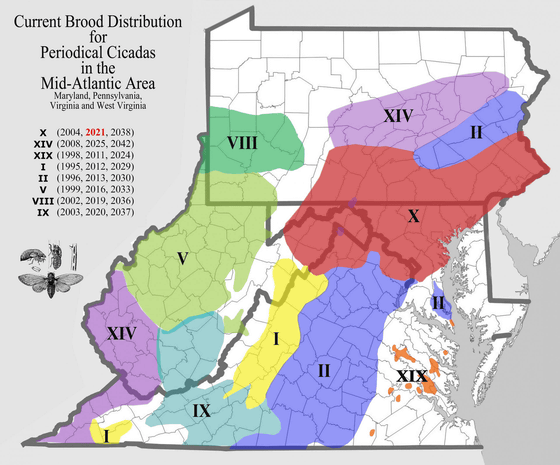The emergence of the periodical cicada 'Brude X', which covers the ground in groups of trillions of animals, begins.

Brood X Periodical Cicadas FAQ (US National Park Service)
https://www.nps.gov/articles/000/cicadas-brood-x.htm
Periodical cicadas are insects belonging to the order Hemiptera, and there are a total of 7 species, mainly inhabiting the Midwest and East Coast of the United States. Flocks of periodic cicadas are called 'Broods' each year they occur, and each blued has a Roman numeral. The group called 'Brood X' will occur in 2021, which is the largest group in the periodical cicadas. Brude X is a periodical cicada that lives in three areas: Pennsylvania, northern Virginia, Indiana, and eastern Tennessee.
The body of the periodic cicada is characterized by a reddish orange color. Green cicadas are a common species that appear every year, so they are easy to identify.


The National Park Service of the United States explains that the timing of the outbreak depends on the weather, but it seems that the timing of emergence will be 'the timing when the ground temperature reaches 64 degrees Fahrenheit (17.8 degrees Celsius)'. .. It is reported that the emergence of Brude X has already begun in some parts, but 'I think it will emerge from the first week to the second week of May and end its life by the end of June,' said the National Park Service of the United States. The Park Service notes. In addition, since normal cicadas emerge from June to August every year, it can be said that Brude X emerges fairly quickly.
Regarding the reason why periodical cicadas occur in large numbers with long cycles such as 17 years and 13 years, the United States National Park Service said, 'There are many predators who eat cicadas, but there are a large number of periodical cicadas that are more than they can eat enough. In other words, periodical cicadas have emerged in large numbers as a survival strategy, leaving seeds behind. ' Creatures that eat periodic cicadas include birds, raccoons, possums, foxes, shrews, frogs, toads, turtles, fish, and massospora cicad.
Massospora cicad is a bacterium that proliferates 'zombie cicadas' that mate with live cicadas and spread the infection while destroying the abdomen of infected cicadas.

After 17 years in the ground, Brude X larvae emerge into the ground and emerge when they become adults. Brude X, which has gone underground, lives on the ground for about a month and dies after mating. Female Brude X lays about 500 eggs on a tree, and the eggs hatch in about 6 weeks. The hatched larvae go underground and reappear on the ground 17 years later due to emergence.
In the periodical cicada, the male comes out to the ground first and squeals by vibrating from the eardrum near the base of the wing, trying to attract the female. Females, on the other hand, click with their wings to indicate their willingness to mate. Periodical cicadas are said to make the loudest sounds in the insect world, singing different songs for each species. Entomologists believe that the reason why periodical cicadas make a loud noise is 'to hurt the ears of predators and protect themselves.'
Some periodical cicadas emerge every 13 years, but the number of individuals is much smaller than that of the 17-year cycle. There are also cicadas with a 21-year cycle. In addition, 12 types of 17-year periodical cicadas and 3 types of 13-year periodical cicadas have been confirmed.

Regarding the environmental impact of the outbreak of periodic cicadas, the United States National Park Service said, 'Females lay eggs on young tree branches, which can harm young trees. Therefore, the spring of 2021 is a young tree. It's not the right time to plant a tree. If you're planting a young tree in 2021, autumn is a good time. If you're planting in the spring, it's best to protect it with a net. '
On the other hand, the outbreak of periodic cicadas is a feast for living things, and research has shown that larger individuals have been confirmed among some birds in the year when periodic cicadas appear. The large number of corpses of periodic cicadas also provide nutrition for the soil.
Periodical cicadas are a native species of the United States, have no risk of chewing or stinging, and are not toxic to pets. However, in the case of shellfish allergies, eating cicadas may cause semi-allergies.
Related Posts:
in Creature, Posted by logu_ii






